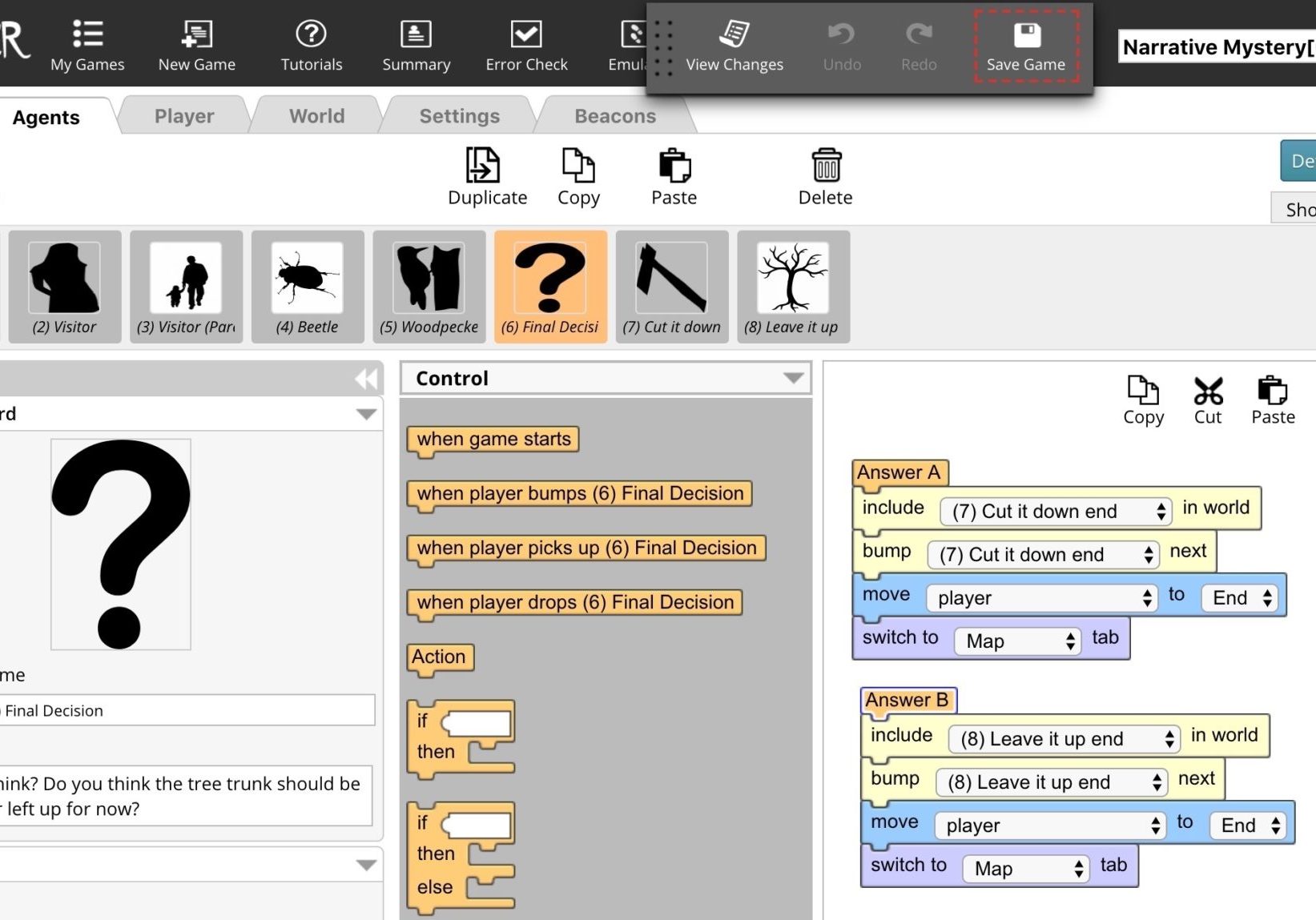Overview
TaleBlazer is a platform for making and playing location-based mobile augmented reality
(AR) games. TaleBlazer players download a free mobile app to their device (Android or
iOS) to play games geolocated in real-world locations. As players move around the
physical space, their devices sense their current location (typically using GPS outdoors
or iBeacons indoors) allowing players to interact with virtual characters, artifacts and
data within the context of real landscapes. These hybrid experiences in TaleBlazer
create new opportunities for dynamic storytelling, informal learning experiences, and
community engagement. The web-based editor uses a visual, blocks-based
programming environment that allows both novices and experts to create their own
location-based AR games. Informal learning venues (including museums, zoos, nature
centers, botanical gardens and others) have created TaleBlazer games, to bring
location-based AR games to their visitors. Organizations including Global Kids and
Seattle Public library have facilitated out-of-school programming in which youth design,
author and implement their own TaleBlazer games, empowering them to create
meaning around themes within their local communities.


Resources
Take advantage of our resources to help you get started creating your own location-based games and experiences including:
Sample Games. Imagine what’s possible by playing sample AR games developed in TaleBlazer.
Getting Started Tutorials. Play and remix games while getting an orientation to the TaleBlazer programming environment.
Game Mechanics Tutorials. Learn about game mechanics available in TaleBlazer.
Game Worksheet. Plan your game using a checklist created by experienced game designers.
Best Practices Guide. Access tips on how to best plan, design and develop your game.
Analytics. Understand how players are using your game.
Research
Vogel, S., & Perry, J. (2018). We got this: Toward a facilitator-youth “apprenticeship” approach to supporting collaboration and design challenges in youth-designed mobile location-based games. In D. Herro, S. Arafeh, R. Ling & C. Holden (Eds.), Mobile learning: Perspectives on practice and policy (Digital Media and Learning), (pp. 143-168). Charlotte, North Carolina: Information Age Publishing, Inc.
Perry, J., Coulter, B., Rubio, J. & Holden, C. (2015). How I Learned to Stop Worrying and Love
Youth Game Creation. Games+Learning+Society, Madison, WI.
Perry, J., & Nellis, R. (2012). Augmented Learning: Evaluating Mobile Location-Based Games at the Zoo. ISTE, San Diego, CA.
Klopfer, E., Coulter, R., Perry, J. & Sheldon, J. Discovering Familiar Places: Learning
through Mobile Place-Based Games. (2012) S. Barab, K. Squire and C. Steinkuehler. Games,
Learning, and Society: Learning and Meaning in the Digital Age. Cambridge University Press
Klopfer, E., Zhang, C., Perry, J., & Sheldon, J. (2010, June). GameBuilder: does reduced
software complexity allow more time on task?. In Proceedings of the 9th International
Conference of the Learning Sciences-Volume 2 (pp. 249-249). International Society of the
Learning Sciences.
Klopfer, E., & Sheldon, J. (2010). Augmenting your own reality: Student authoring of
science‐based augmented reality games. New directions for youth development, 2010(128), 85-94.
Klopfer, E. (2008). Augmented learning: Research and design of mobile educational games.
MIT Press.
Chelberg, D., Perry, J., Annetta, L. & Searson, M. (2008). Enriching STEM Education through
Games and Simulations. In K. McFerrin et al. (Eds.), Proceedings of Society for Information
Technology &Teacher Education International Conference 2008 (pp. 5343-5349). Chesapeake, VA: AACE.
Perry, J., Klopfer, E., Norton, M., Sutch, D., Sandford, R., & Facer, K. (2008, June). AR gone
wild: two approaches to using augmented reality learning games in Zoos. In Proceedings of the 8th international conference on International conference for the learning sciences-Volume 3 (pp.322-329). International Society of the Learning Sciences.
Rosenbaum, E., Klopfer, E., Boughner, B., & Rosenheck, L. (2007, July). Engaging students in
science controversy through an augmented reality role-playing game. In Proceedings of the 8th international conference on Computer supported collaborative learning (pp. 612-614).
International Society of the Learning Sciences.
Rosenbaum, E., Klopfer, E., & Perry, J. (2007). On location learning: Authentic applied science with networked augmented realities. Journal of Science Education and Technology, 16(1), 31-45.
Klopfer, E., Perry, J., Squire, K., Jan, M., Steinkuehler, C. (2005). Mystery at the museum: a
collaborative game for museum education. In Proceedings of the 2005 conference on Computer support for collaborative learning: learning 2005: the next 10 years! (CSCL '05). International Society of the Learning Sciences 316-320.
